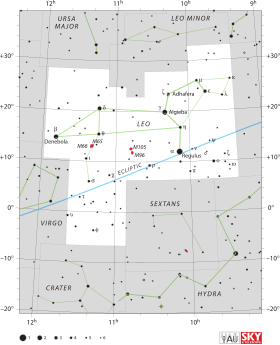Theta Leonis
| Ascension droite | 11h 14m 14,405s |
|---|---|
| Déclinaison | +15° 25′ 46,45″ |
| Constellation | Lion |
| Magnitude apparente | 3,324 |
Localisation dans la constellation : Lion | |
| Type spectral | A0V |
|---|---|
| Indice U-B | 0,06 |
| Indice B-V | −0,01 |
| Indice R-I | −0,03 |
| Vitesse radiale | 7,6 km/s |
|---|---|
| Mouvement propre |
μα = −59,01 mas/a μδ = −79,37 mas/a |
| Parallaxe | 18,36 ± 0,77 mas |
| Distance |
178 ± 8 al (54,5 ± 2,3 pc) |
| Magnitude absolue | −0,35 |
| Masse | 2,75-2,9 M☉ |
|---|---|
| Rayon | 4,3 R☉ |
| Luminosité | 120 L☉ |
| Température | 9 320 K |
| Rotation | 23 km/s |
| Âge | 450 × 106 a |
Désignations
Theta Leonis (θ Leo / θ Leonis, Thêta Leonis) dans la Désignation de Bayer est une étoile de la constellation du Lion.
Nomenclature
[modifier | modifier le code]Elle porte les noms traditionnels suivants :
- Chertan est le nom aujourd'hui approuvé par l'Union astronomique internationale (UAI) [2]. Ce nom vient de l’arabe الخراتان al-Ḫarātān, d’origine inconnue, qui un des noms de la XIe des manāzil al-qamar ou « stations lunaires », formée par δθ Leo dans le cadre du ciel arabe traditionnel[3]. Le nom est d’abord introduit avec les listes latines de l’an mil, notamment sous la forme Alcoratein. Il devient ensuite nom d'une étoile individuelle sous la forme Chertan avec Jack W. Rhoads (1971) à partir de la transcription AlCheratân donnée par Thomas Hyde (1665) dans sa traduction du سلطانی Zīğ-i Sulṭānī ou « Tables sultaniennes » d’Uluġ Bēg (1437) du traité d’Uluġ Bēg (1437)[4], et spécialisé sur δ Leo[5].
- Chort : ce terme, introduit par Benjamin E. Smith (en) (1898)[6], a suivi le même chemin que le précédent depuis l’arabe. Donné pour le nom individuel de chaque étoile du couple δθ Leo, c’est l’arabe الخرت al-Ḫurt, littéralement « la Perforation, le Trou [fait par une aiguille] », mais ce terme n’est pas le singulier de الخراتان al-Ḫarātān, qui est الخراه al-Ḫarāt[7].
- Coxa, littéralement « la Hanche » en latin, appellation donnée à la Renaissance à partir d’une traduction de textes arabes pour « hanche »[8].
Propriétés
[modifier | modifier le code]Theta Leonis est une étoile blanche de la séquence principale de type spectral A0V. Sa magnitude apparente est de +3,32. Elle est à environ 178 années-lumière de la Terre.
Notes et références
[modifier | modifier le code]- (en) * del Leo -- High proper-motion Star sur la base de données Simbad du Centre de données astronomiques de Strasbourg.
- « Comment sont nommées les étoiles? », sur iau.org, Union astronomique internationale (consulté le ).
- Roland Laffitte, « Les deux figures du Lion dans le ciel arabe, site URANOS ».
- (la) Thomas Hyde, « Tabulae Long. ac Lat. Stellarum Fixarum ex Observatione Ulugh Beighi, Tamerlanis Magni Nepotis, Oxonii : Henry Hall, 1665, Commentarii, p. 37. »
- Roland Laffitte, Héritages arabes. Des noms arabes pour les étoiles, Paris : Geuthner, 2005, p. 111.
- (en) Benjamin Eli Smith, The Century cyclopedia of names; a pronouncing and etymological dictionary of names in geography, biography, mythology, history, ethnology, art, archaeology, fiction, etc., New York : The Century Co, Century Cyclopedia of Names, (lire en ligne), p. 248
- Voir Paul Kunitszch & Tim Smart, A Dictionary of Modern Star Names : Cambridge (Ma) : Sky & Telescope, 1986, p. 42.
- Idem.
Bibliographie
[modifier | modifier le code]- [Monier 2022] Richard Monier, « The Abundances of Zinc and Copper in the Atmospheres of 78 Vir (A2p SrCrEu) and θ Leo (A2 IV) », Research Notes of the AAS, vol. 6, no 1, , p. 15 (lire en ligne)
Liens externes
[modifier | modifier le code]- (en) Theta Leonis sur la base de données Simbad du Centre de données astronomiques de Strasbourg.
- (en) James B. Kaler, « Chertan », sur Stars
Text is available under the CC BY-SA 4.0 license; additional terms may apply.
Images, videos and audio are available under their respective licenses.

